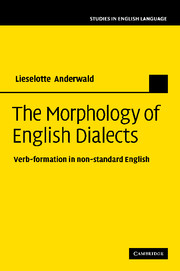Book contents
- Frontmatter
- Contents
- List of figures
- List of maps
- List of tables
- Preface and thanks
- Acknowledgement of sources
- 1 Introduction
- 2 Past tense theories
- 3 Naturalness and the English past tense system
- 4 Sellt and knowed: non-standard weak verbs
- 5 Drunk, seen, done and eat: two-part paradigms instead of three-part paradigms
- 6 Come and run: non-standard strong verbs with a one-part paradigm
- 7 Conclusion: supralocalization and morphological theories
- Appendix 1 Verb classification
- Appendix 2 SED localities and list of counties
- Bibliography
- Index
6 - Come and run: non-standard strong verbs with a one-part paradigm
Published online by Cambridge University Press: 30 July 2009
- Frontmatter
- Contents
- List of figures
- List of maps
- List of tables
- Preface and thanks
- Acknowledgement of sources
- 1 Introduction
- 2 Past tense theories
- 3 Naturalness and the English past tense system
- 4 Sellt and knowed: non-standard weak verbs
- 5 Drunk, seen, done and eat: two-part paradigms instead of three-part paradigms
- 6 Come and run: non-standard strong verbs with a one-part paradigm
- 7 Conclusion: supralocalization and morphological theories
- Appendix 1 Verb classification
- Appendix 2 SED localities and list of counties
- Bibliography
- Index
Summary
Run (rΛn), v. […] A verb of complicated history in Eng[lish] …
(OED: s.v. run v.)Past tensecome
Introduction
He was at sea f' Christmas and she come in — there was just the wheel there. (FRED SFK 033) (Suffolk, South East)
We had to stop it when he come from the war. (FRED NTT 006) (Nottinghamshire, Midlands)
She wouldn't cut the bread when it come out the bakehouse, it was too hot. (FRED LAN 002) (Lancashire, North)
The non-standard use of come in the past tense is generally well known and seems to be a feature of enormous geographical spread — indeed Chambers includes it under his vernacular universals as one of ‘the most ubiquitous’ ‘markers of W[orking] C[lass] speech in widely scattered areas of the English-speaking world’ (Chambers 1995: 240). Chambers' inclusion of past tense come as a general indicator of ‘mainstream non-standard’ English (Chambers 1995: 241) equally means that this feature is so frequent it would qualify not as a dialect feature in the strict sense, but as a general non-standard feature. Past tense come is also mentioned by Wolfram and Schilling-Estes (1998: 332) for the majority of vernaculars in the US North and South, and is one of the most frequent non-standard past tense forms in Poplack and Tagliamonte's study of diaspora varieties of African American English (Poplack and Tagliamonte 2001).
- Type
- Chapter
- Information
- The Morphology of English DialectsVerb-Formation in Non-standard English, pp. 149 - 182Publisher: Cambridge University PressPrint publication year: 2009



